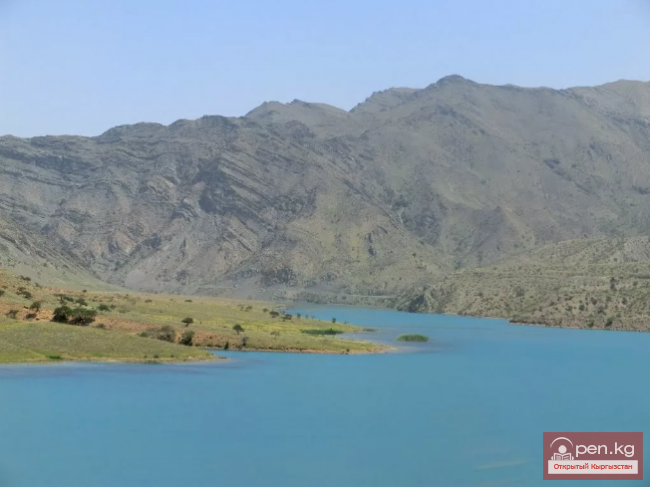
In the Batken region, a few kilometers west of the village of Samarkandyk, in the Shadymir area of...

Ala-Myshyk Cave - Colorful Cat On the ridge of the mountain range rising above the surroundings of...

Cave Named After Academician A. E. Fersman About 20 km south of Chyl Ustun, in the Tuy-Moyun...

Kok-Kiya River (Green Slope) - the easternmost right tributary of Ak-Sai, flows down from the...

The Chil-Ustun Zone includes the Chil-Ustun, Chil-Mayram, and Keklik-Too mountains located around...

Caves of Kyrgyzstan Caves are rightly called the cradle of humanity. Primitive people took shelter...

Naryn State Reserve is located 50 km east of the city of Naryn on the left bank of the river. The...

If Kyrgyzstan is the country of the Tian Shan, then Tajikistan is the country of the Pamirs. The...

Suleiman Mountain (Throne of King Solomon) is located in the center of the city of Osh. The height...

During the period under consideration, the Kyrgyz population occupied approximately the same part...

Jidalyk - "breast berry" Jidalyk (Zhiydeli) is a famous lake in Kadamjay. It is a...

Kasansay (Kyrgyz: Kasan-say, Uzbek: Kosonsoy) A river in Kyrgyzstan and Uzbekistan, a right...

THE GOOD MAN AND THE ENVIOUS MAN Once upon a time, a good man and an envious man set off together...

How Animals Paved the Great Silk Road “The ‘discoverers’ of the Great Silk Road were animals,” say...

A more inaccessible area of Kyrgyzstan than Sary-Jaz was hard to imagine until recently. Here lies...
Collectible coins "Argali" and "Edelweiss," dedicated to the International Year...

The "Kyzyl-Unkyur" Zone is located 15 km northeast of the village of Arslanbap in the...

The Batken Region was established on October 12, 1999, from the Osh Region. It includes the...

Since April 2, 2007, the National Bank of the Kyrgyz Republic has put into circulation a...

This area includes the city of Naryn — a transport and distribution tourist center — and its...

The Shakhimardan Zone (Shaimerden) encompasses the basin of the Shakhimardan-Sai River. There is a...

MONUMENT FROM KOK-TALGY-ATA The inscription on the kairak, located in the territory of...

The National Bank of the Kyrgyz Republic has issued a commemorative collector's coin...

Aydarken – a small town and industrial center in the central part of the Batken region. The...

Karakulja The Chatkal River in its upper reaches is called Karakulja (translated - Black Ram),...
The ski resort "Too Ashuu" is a modern complex for people who prefer a healthy and...

Famous Russian traveler Fyodor Konyukhov is preparing his expedition to Lake Issyk-Kul to search...

Glaciers of the Kyrgyz Ala-Too The highlands of the Kyrgyz Range feature a deeply dissected alpine...

Narrow echoing gorges, through which in the gloomy depths flows a river bound by rocky jaws;...

Lake Köl-Suu translates as "coming water" The lake is located in the Naryn region,...

CHRISTMAS ISLAND Located in Oceania, in the southeastern part of the Indian Ocean, 2623 km...

The first reliable traces of humans on the territory of Kyrgyzstan date back to the Paleolithic —...

Usy, Han-Hena, and Yilanzhou In the "Yuan-Shi," in relation to the land of the Kyrgyz,...

Rocky Canyons of the Kok-Kiya Valley Kyrgyzstan is rich in beautiful and unique places. In the...

Osh - one of the oldest cities in Central Asia, located on the southeastern edge of the Fergana...

All political entities of the Middle Ages in the territory of Central Asia somehow affected the...

Categories of Protected Natural Areas in Kyrgyzstan Kyrgyzstan has established 83 special...

About Deserts 1. Deserts cover about one-fifth of the Earth's land surface, with half of this...

Burana - Architectural Heritage. Located 12 km southwest of the present-day town of Tokmak is the...

Collectible coin "Han-Tengri", dedicated to the 10th anniversary of the independence of...

10 Attractions in Crimea. The Crimean Peninsula is a unique historical and cultural reserve. For...

Attempts to Circumvent Legislation on the Expansion of Waqf The conversion of real estate into...

Batken is a city in Kyrgyzstan, the administrative center of Batken Region and District. The...

The forge of the zergers. Mid-19th century. The photo is kept in the State Historical Museum...

An elderly man settled in a cave in the Jalal-Abad region of Kyrgyzstan. As 68-year-old Tolon...

Kozho-Kelen – a true wonder of nature The Kozho-Kelen Valley (Kozhokelen, Khojo-Kelen,...

The Saka tribes were divided into three parts. In the southern regions of Kyrgyzstan lived the...

THE ORIGIN AND DEVELOPMENT OF BISHKEK Findings of stone tools by archaeologists during the...